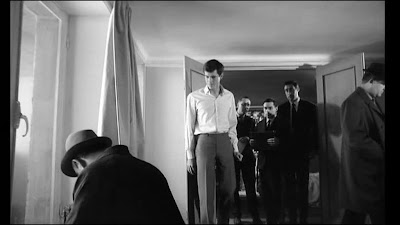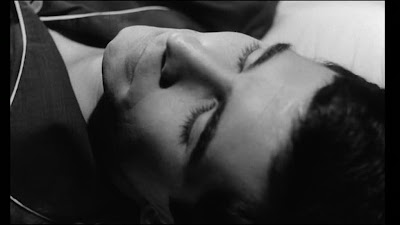[Search Blog Here.]
[Central Entry Directory]
[Cinema Entry Directory]
[Filmmakers, Entry Directory]
[Orson Welles, Entry Directory]

What must be noted is that depth of field sometimes shows us evocation in the act of occurring and sometimes virtual sheets of past that we explore in order to find the recollection sought. The first case, contraction , often appears in Citizen Kane: a high-angle shot, for instance, bears down on an alcoholic Susan lost in the big room at the club in such a way as to force her to evoke. In another case, in The Magnificent Ambersons, a whole scene maintained in depth is justified because the young boy wants, without appearing to want, to force his aunt to remember a recollection that is crucial for him. [ft.18: “Bazin has often analysed this kitchen scene, but without making it dependent on the function of remembering which takes place (or tries to take place) in it. [...].”] And similarly, in The Trial, the low angle shot at the beginning marks the starting-point of the hero’s efforts as he searches at all costs for what the law is charging him with. The second case can be seen in most of the scenes in transverse depth in Citizen Kane, where each corresponds to a sheet of past of which it is asked: is it here that the virtual secret, Rosebud, is lying? And in Mr. Arkadin, where the successive characters are sheets of past, stages towards other sheets, all coexisting in relation to the contracted initial effort. [Deleuze Cinema 2, 1989: 106b.d; 289d(ft.18)]
Le fait à constater, c’est que la profondeur de champ nous montre tantôt l’évocation en acte, tantôt les nappes virtuelles de passé qu’on explore pour y trouver le souvenir cherché. Le premier cas, la contraction, apparaît souvent dans « Citizen Kane » : par exemple une plongée se dirige sur Susan alcoolique et perdue dans la grande pièce du cabaret, pour la forcer à évoquer. Ou bien, dans « La splendeur des Ambersons », toute une scène fixe en profondeur se justifie parce que le jeune garçon veut, sans en avoir l’air, forcer sa tante à se rappeler un souvenir essentiel pour lui. [ft.17 : "Basin a souvent analysé cette scène de la cuisine, mais sans la faire dépendre de la fonction de mémoration que s’y exerce (ou tente de s’y exercer)."] Et aussi dans « Le procès », la contre-plongée du début marque le point de départ des efforts du héros, cherchant à tout prix ce que la justice peut lui reprocher. Le second cas apparaît dans la plupart des scènes en profondeur transversale dans « Citizen Kane », où chacune correspond à une nappe de passé dont on se demande : est-ce là qui gît le secret virtuel, Rosebud ? Et dans « M. Arkadin », où les personnages successifs sont des nappes de passé, relais vers d’autres nappes, toutes coexistantes par rapport à l’effort initial contracté. [Deleuze Cinéma 2, 1985: 144a.c]



Deleuze, Gilles. Cinema 2: The Time Image. Transl. Hugh Tomlinson and Robert Galeta. London & New York: 1989.
Deleuze, Gilles. Cinéma 2: L'image-temps. Paris: Les éditions de minuit, 1985.




No comments:
Post a Comment